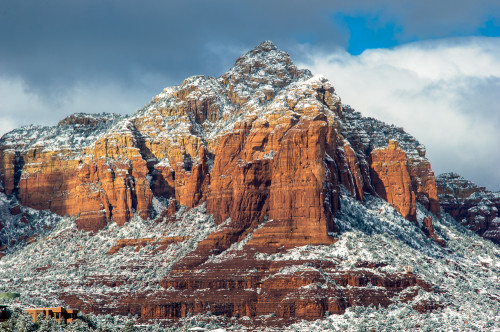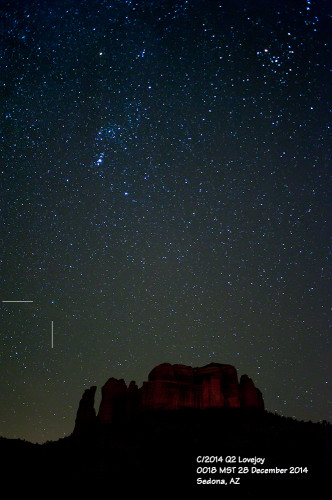Comet Lovejoy (known formally as C/2014 Q2) continues to put on an impressive show for sky watchers. In December it began to climb upwards from the southern horizon towards Orion, then passing to its west and climbing higher. In mid-January it was nearly overhead in the evening sky as it passed near Taurus and Pleiades. Many astrophotographers have taken advantage of this setting and there have been some beautiful photographs posted at various web sites.
To best capture the delicate details of the comet—and especially its tail—a tracking device is needed to guide your camera or telescope so that it matches the motion of the stars across the sky. This allows longer exposures without the stars streaking or creating star trails. Without a tracking device, exposure time is limited. This limitation can be partially overcome by taking numerous short exposure images and stacking them using any of the many applications available. Still, the laws of physics and the engineering of camera sensors will result in better images if you have, say, five 30-second exposures than thirty 5-second exposures—even though both are 150 seconds total exposure.
From the DeepSkyStacker pages on the theory of stacking:
Are 100 x 1 minute and 10×10 minutes giving the same result?
Yes when considering the SNR but definitely No when considering the final result. The difference between a 10-minutes exposure and a 1-minute exposure is that the SNR in the 10-minutes exposure is 3.16 higher than in 1-minute exposure.Thus you will get the same SNR if you combine 10 light frames of 10 minutes or 100 light frames of 1 minute. However you will probably not have the same signal (the interesting part). Simply put you will only get a signal if your exposure is long enough to catch some photons on most of the light frames so that the signal is not considered as noise.
For example for a very faint nebula you might get a few photons every 10 minutes. If you are using 10 minutes exposures, you will have captured photons on each of your light frames and when combined the signal will be strong. If you are using 1 minute exposures you will capture photons only for some of your light frames and when combined the photons will be considered as noise since they are not in most of the light frames.
Since I don’t have a tracker (at least, not yet), I have no choice but to stack short-exposure images of the comet. Here are a few images of Comet C/2014 Q2 Lovejoy taken on several different nights. The quality of the images varies depending on how much light pollution was captured in the image, whether there was moonlight, and how clear the sky was.




There’s still plenty of time this winter to venture outside with a pair of binoculars and gaze at the comet. Here is a link to a sky chart provided by Sky and Telescope for the month of January. For February and beyond, try this chart hosted by UniverseToday.
Happy viewing!















